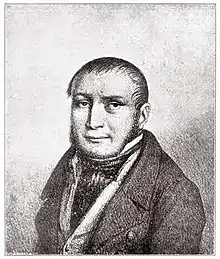Louis-Charles Mahé de La Bourdonnais
Louis-Charles Mahé de La Bourdonnais (1795–December 1840) was a French chess master, possibly the strongest player in the early 19th century.
| Louis de La Bourdonnais | |
|---|---|
 The only known likeness of La Bourdonnais. | |
| Full name | Louis-Charles Mahé de La Bourdonnais |
| Country | France |
| Born | 1795 Réunion |
| Died | December 1840 (aged 44–45) London, Great Britain |
Early life
La Bourdonnais was born on the island of La Réunion in the Indian Ocean in 1795. He was the grandson of Bertrand-François Mahé de La Bourdonnais. He learned chess in 1814 and began to take the game seriously in 1818, regularly playing at the Café de la Régence.[1] He took lessons from Jacques François Mouret, his first teacher,[2] and within two years he became one of the best players of the Café.
Chess career
La Bourdonnais was forced to earn his living as a professional chess player after squandering his fortune on ill-advised land deals. He played in an era before a World Chess Championship was established, but was considered to be perhaps the strongest player in the world from 1821 — when he became able to beat his chess teacher Alexandre Deschapelles — until his death in 1840. The most famous match series in that time was the series against Alexander McDonnell in 1834. These matches of 85 games were analyzed by Kasparov in his book My Great Predecessors.
Death
He died penniless in London in December 1840,[3] having been forced to sell all of his possessions, including his clothes, to satisfy his creditors. George Walker arranged to have him buried just a stone's throw away from his old rival Alexander McDonnell in London's Kensal Green Cemetery.[4][5]
Notable games
| a | b | c | d | e | f | g | h | ||
| 8 |  | 8 | |||||||
| 7 | 7 | ||||||||
| 6 | 6 | ||||||||
| 5 | 5 | ||||||||
| 4 | 4 | ||||||||
| 3 | 3 | ||||||||
| 2 | 2 | ||||||||
| 1 | 1 | ||||||||
| a | b | c | d | e | f | g | h | ||
- Alexander McDonnell vs. Louis-Charles Mahé de La Bourdonnais, 16, London 1834, Sicilian Defense: Old Sicilian. Open (B32), 0–1 A game demonstrating the strength of pawns. Its end position is one of the most surprising in the history of chess.
- Louis-Charles Mahé de La Bourdonnais vs. Alexander MacDonnell, 3, London 1834, Queen's Gambit Accepted: Old Variation (D20), 1–0 La Bourdonnais punishes McDonnell's premature attack.
Notes
- The Oxford Companion to Chess – David Hooper and Kenneth Whyld (1992) p. 56
- Le Palamède edited by Saint-Amant (1847) p. 211
- Crescendo of the Virtuoso: Spectacle, Skill, and Self-Promotion in Paris during the Age of Revolution. Paul Metzner, Berkeley: University of California Press, c1998 1998.
- Philip W. Sergeant, A Century of British Chess, David McKay, 1934, p. 39.
- Walker, George (1850). Chess and Chess-Players. London: C. J. Skeet.
References
- World chess champions by Edward G. Winter, editor. 1981 ISBN 0-08-024094-1
External links
| Wikimedia Commons has media related to Louis-Charles Mahé de La Bourdonnais. |
- Louis-Charles Mahé de La Bourdonnais player profile and games at Chessgames.com